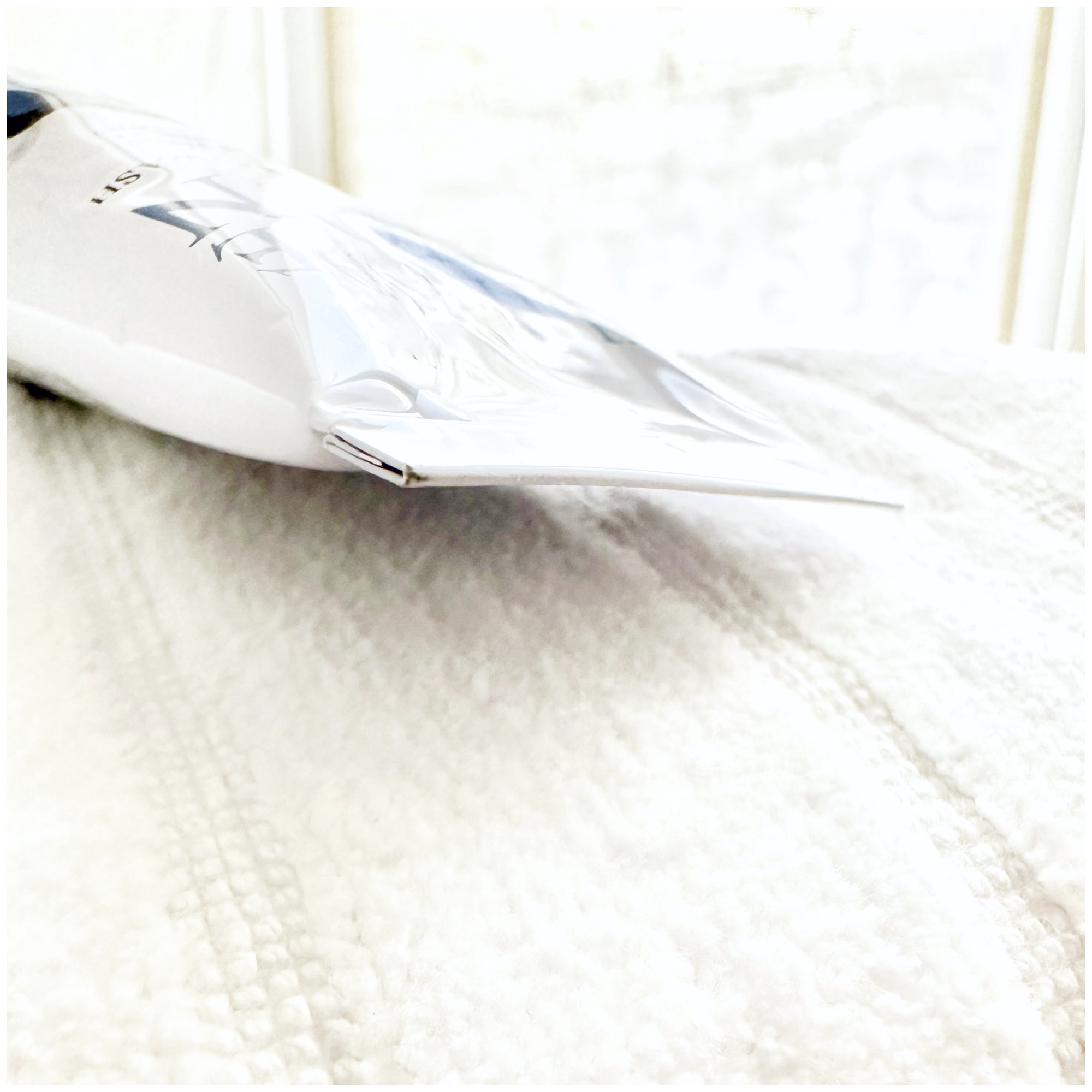Allergen
Flower Extracts, Flowers
Perhaps not all flowers are top contact allergens (butterfly pea flower is an exception, for example) but there are so many that it is prudent to classify them as allergens and best practice to avoid them and their extracts if you have sensitive skin.
Many types of reactions
Many flowers don’t just cause redness, itching, and dryness. Some people may react with swelling and blisters.
Because many of these allergens are also photo-allergens, they can cause photo-sensitivity as well as melasma and other types of hyperpigmentation.
These allergens are in so many things that reactions can occur almost everywhere, from hands and face, to armpits, legs, and more.
Because of pollens (and fragrances in products) can be carried by wind or waft upwards, airborne contact dermatitis is not unusual for this allergy and can affect all exposed areas of skin (face, neck, arms, etc.). More specifically on face and neck, reactions tend to occur on eyelids, sides of neck, jawline, and on the backs of the ears (because airborne allergens tend to collect more on those areas).
All the reactions above can occur on several areas, even where not directly applied.
Many fragrances are related to flavors. When eaten, your allergen may stimulate a skin reaction, causing it to reappear or worsen. Gut and systemic reactions, however, are fairly rare.
What to avoid
A common sensitivity is to the sesquiterpene lactones in many flowers, especially in the Composite or Asteraceae family. This includes daisies, sunflowers, feverfew (chrysanthemum), and asters, plus chamomile, arnica, and over 20,000 other herbs, vegetables, and plants. Of particular concern in this group are the flowers, leaves, stems and pollen which contain sesquiterpene lactones.
Another problematic flower family is the Amaryllidaceae or lily family (hundreds here, too). The allergen culprits here are the lactone (those lactones again) tulipalin A and Alpha-methylene-gamma-butyrolactone.
If you’ve patch tested positive to sesquiterpene lactone mix, you should avoid costunolide, alantolactone, and dehydrocostus lactone, coumarin, monoterpenes (camphor, limonene, terpinene, pinene), thiophene, and other “lactone” ingredients.
Over a third of people with allergic contact dermatitis to compositae are also allergic to fragrance, Balsam of Peru, and colophony (rosin). Other things that are related to or commonly cross react with fragrance include benzyl alcohol, beeswax and propolis; and many flavors. See a more comprehensive list here.
Another top contact allergen is rose oil or Bulgarian, which is also in many products and is related to many other allergens.
Patch testing is your friend: make sure to go over your results with your dermatologist to understand which allergens and cross reactants you need to avoid for sustained clarity and comfort.
Some best practices:
- As a rule, avoid products (many of them labeled “natural,” “clean,” or “vegan”) with flower extracts. There are natural ingredients that are not allergens like pure green tea and virgin coconut oil but many (many) flower and fruit extracts are top contact allergens. Be guided by your patch test results for best results.
- Avoid fragrance, masking fragrances, and essential oils as much as possible in as many things as possible — cosmetics, hair care, skincare but also scented candles, aromatherapy, room fresheners, bleaches and disinfectants, furniture and floor polish, pet products, toilet and kitchen cleaning supplies, laundry products … everything.
- Use shampoo-body wash, conditioner, skincare, and makeup with zero contact allergens and irritants (perfumes can be “sticky” so it’s best to reduce allergen and fragrance exposure everywhere that you can).
- When gardening, working, or hiking outdoors or when handling flowers, use protective gloves and a face cover. Make sure they’re of a material and color that you are not sensitive to (your patch test can guide you) or that are not top contact allergens themselves (latex, rubber, black colorant and other dyes are common allergens). Applying a purely mineral, non-comedogenic barrier-protective product like Stay-On-Point! or Armada Baby or Post-Procedure on your hands and exposed skin before putting on your gloves and face cover may provide further protection from the oils (remember their scents can be airborne).
- When coming in from the outdoors, change out of clothes as quickly as possible. Ideally, use an allergen-free laundry soap such as Fawn & Lauder or even Superwash!
- Feeling overwhelmed? Sometimes it feels like a LOT trying to follow your patch test results. This is precisely why we offer the service to customize recommendations for you based on your patch test results and potential cross reactants!
Subscribe to VMVinSKIN.com and our YouTube channel for more hypoallergenic tips and helpful “skinformation”!
If you have a history of sensitive skin…
…don’t guess! Random trial and error can cause more damage. Ask your dermatologist about a patch test.
To shop our selection of hypoallergenic products, visit vmvhypoallergenics.com. Need help? Ask us in the comments section below, or for more privacy (such as when asking us to customize recommendations for you based on your patch test results) contact us by email, or drop us a private message on Facebook.
For more:
- On the prevalence of skin allergies, see Skin Allergies Are More Common Than Ever.
- For the difference between irritant and allergic reactions, see It’s Complicated: Allergic Versus Irritant Reaction.
- For the difference between food, skin, and other types of reactions: see Skin & Food Allergies Are Not The Same Thing.
- On the differences between hypoallergenic, natural, and organic, check out Is Natural Hypoallergenic? and this video in our YouTube channel.
- To learn about the VH-Rating System and hypoallergenicity: What Is The Validated Hypoallergenic Rating System?
Main References:
Regularly published reports on the most common allergens by the North American Contact Dermatitis Group and European Surveillance System on Contact Allergies (based on over 28,000 patch test results, combined), plus other studies. Remember, we are all individuals — just because an ingredient is not on the most common allergen lists does not mean you cannot be sensitive to it, or that it will not become an allergen. These references, being based on so many patch test results, are a good basis but it is always best to get a patch test yourself.
- DeKoven JG, Silverberg JI, Warshaw EM, Atwater AR, et al. North American Contact Dermatitis Group Patch Test Results: 2017-2018. Dermatitis. 2021 Mar-Apr 01;32(2):111-123.
- DeKoven JG, Warshaw EM, Zug KA, et al. North American Contact Dermatitis Group Patch Test Results: 2015-2016. Dermatitis. 2018 Nov/Dec;29(6):297-309.
- DeKoven JG, Warshaw EM, Belsito DV, et al. North American Contact Dermatitis Group Patch Test Results 2013-2014. Dermatitis. 2017 Jan/Feb;28(1):33-46.
- Warshaw, E.M., Maibach, H.I., Taylor, J.S., et al. North American contact dermatitis group patch test results: 2011-2012. Dermatitis. 2015; 26: 49-59.
- W Uter et al. The European Baseline Series in 10 European Countries, 2005/2006–Results of the European Surveillance System on Contact Allergies (ESSCA). Contact Dermatitis 61 (1), 31-38.7 2009.
- Wetter, DA et al. Results of patch testing to personal care product allergens in a standard series and a supplemental cosmetic series: An analysis of 945 patients from the Mayo Clinic Contact Dermatitis Group, 2000-2007. J Am Acad Dermatol. 2010 Nov;63(5):789-98.
- Warshaw EM, Buonomo M, DeKoven JG, et al. Importance of Supplemental Patch Testing Beyond a Screening Series for Patients With Dermatitis: The North American Contact Dermatitis Group Experience. JAMA Dermatol. 2021 Dec 1;157(12):1456-1465.
- Verallo-Rowell VM. The validated hypoallergenic cosmetics rating system: its 30-year evolution and effect on the prevalence of cosmetic reactions. Dermatitis 2011 Apr; 22(2):80-97.
- Ruby Pawankar et al. World Health Organization. White Book on Allergy 2011-2012 Executive Summary.
- Misery L et al. Sensitive skin in the American population: prevalence, clinical data, and role of the dermatologist. Int J Dermatol. 2011 Aug;50(8):961-7.
- Warshaw EM1, Maibach HI, Taylor JS, Sasseville D, DeKoven JG, Zirwas MJ, Fransway AF, Mathias CG, Zug KA, DeLeo VA, Fowler JF Jr, Marks JG, Pratt MD, Storrs FJ, Belsito DV. North American contact dermatitis group patch test results: 2011-2012.Dermatitis. 2015 Jan-Feb;26(1):49-59.
- Warshaw, E et al. Allergic patch test reactions associated with cosmetics: Retrospective analysis of cross-sectional data from the North American Contact Dermatitis Group, 2001-2004. J AmAcadDermatol 2009;60:23-38.
- Foliaki S et al. Antibiotic use in infancy and symptoms of asthma, rhinoconjunctivitis, and eczema in children 6 and 7 years old: International Study of Asthma and Allergies in Childhood Phase III. J Allergy Clin Immunol. 2009 Nov;124(5):982-9.
- Kei EF et al. Role of the gut microbiota in defining human health. Expert Rev Anti Infect Ther. 2010 Apr; 8(4): 435–454.
- Thavagnanam S et al. A meta-analysis of the association between Caesarean section and childhood asthma. Clin Exp Allergy. 2008;38(4):629–633.
- Marks JG, Belsito DV, DeLeo VA, et al. North American Contact Dermatitis Group patch-test results, 1998 to 2000. Am J Contact Dermat. 2003;14(2):59-62.
- Warshaw EM, Belsito DV, Taylor JS, et al. North American Contact Dermatitis Group patch test results: 2009 to 2010. Dermatitis. 2013;24(2):50-99.
- Verallo-Rowell V. M, Katalbas S.S. & Pangasinan J. P. Natural (Mineral, Vegetable, Coconut, Essential) Oils and Contact Dermatitis. Curr Allergy Asthma Rep 16,51 (2016) . https://doi.org/10.1007/s11882-016-0630-9.
- Park G, Oh DS, Lee MG, Lee CE, Kim YU. 6-Shogaol, an active compound of ginger, alleviates allergic dermatitis-like skin lesions via cytokine inhibition by activating the Nrf2 pathway. Toxicol Appl Pharmacol. 2016 Nov 1;310:51-59. doi: 10.1016/j.taap.2016.08.019. Epub 2016 Aug 22. PMID: 27562088.
- de Groot AC. Monographs in Contact Allergy, Volume II – Fragrances and Essential Oils. Boca Raton, FL: CRC Press Taylor & Francis Group; 2019.
- De Groot AC. Monographs in Contact Allergy Volume I. Non-Fragrance Allergens in Cosmetics (Part I and Part 2). Boca Raton, Fl, USA: CRC Press Taylor and Francis Group, 2018.
- Zhu TH, Suresh R, Warshaw E, et al. The Medical Necessity of Comprehensive Patch Testing. Dermatitis. 2018 May/Jun;29(3):107-111.
Want more great information on contact dermatitis? Check out the American Contact Dermatitis Society, Dermnet New Zealand, the Contact Dermatitis Institute, and your country’s contact dermatitis association.

Laura is our “dew”-good CEO at VMV Hypoallergenics and eldest daughter of VMV’s founding dermatologist-dermatopathologist. She has two children, Madison and Gavin, and works at VMV with her family and VMV’s signature “skinfatuated, skintellectual, skingenious” team. In addition to saving the world’s skin, Laura is passionate about health, cultural theory, human rights, happiness, and spreading goodness (like a VMV cream)!







